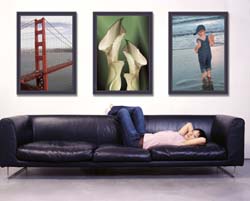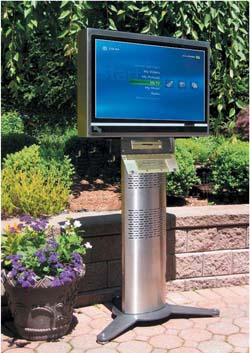- While most trade shows tend to focus on products for a particular market segment, industries are no longer as tightly segmented as they used to be. In days gone by, a residential installer would steer clear of shows such as NAB or NSCA, just as a commercial systems professional would turn their nose up at a show such as CEDIA Expo under the impression that the products displayed for the seemingly "looser" requirements of the residential market would either have no application or not be "tough" enough for the professional world. For many reasons, that is no longer the case, nor should it have been.
The Arris Regale Outdoor Media Center from Sunnytech/Lux Entertainment
Some reasons have to do with the increased demand for high-quality and flexibly-controlled products in the non-commercial world. At the same time, manufacturers are in many cases offering what is basically the same product to the home and commercial worlds with minor feature or performance differentiations as needed either for regulatory issues or to maintain orderly distribution. Sometimes products that don't seem appropriate or useful in one market may be just right for that odd, or perhaps not so odd application on the other side.
There may not be enough of these to make it worthwhile for you to visit a trade show outside your normal list, but you should be aware of what is going on in other market segments. Some of you may have attended the CEDIA Expo in Denver this past September, but most of you probably did not. This month I bring you some off-the-beaten-path products from CEDIA Expo that you might not see at the shows you do go to that just might make a difference in a project you are working on.
If nothing else, it is worth taking a look at some of the things you might otherwise pass by. And in the long run, they could make the difference between getting the gig and losing it to a competitor.
Behind The Walls
One need that commercial and residential installers share is the requirement to pre-wire a job while the walls are open, leave the wires hanging until after the walls are covered, and then you return for the actual product installation and trim out. Both sides of the fence have to deal with not only problems of making sure that any in-wall, flush mount products are not interfered with by any insulation that is packed in, or sprayed on, the walls. They also have to deal with making sure that things don't go awry when the plasterers come in to close the walls. That's where a line of "BackBoxx" products from Professional Partners seen at CEDIA Expo comes into play.
Easy to nail to studs or ceiling joists on either 16-inch or 24-inch centers, these are exactly what their name implies: code approved, lightweight plastic boxes that protect the wiring you have run, "mark" your space so that another trades-person doesn't plant a box, ring, or device where you need room. Flexible and easy to install with a staple gun, they also provide a backing area when you are using trim-rings or "backless j-boxes," and they help to maintain a vapor barrier while protecting the speaker or device that eventually gets installed from dirt and loose insulation.
The same could be said for the products displayed at CEDIA Expo from Active Thermal Management. Taking on a specific task, they showed a wide range of forced air cooling products designed to keep gear functioning without raising the noise floor in the room. While we've all long placed fans in racks and enclosures, ATM goes the full route by incorporating vent lines for air handling at both inlet and outlet, speed controls and thermal sensors, and tubing designed to get the air flow where it is needed. Of particular interest when high-light output projectors are in use are their products for projector enclosures.
Of course, when you need to put not only a screen, but a full fledged PC system in the great outdoors, you'll need more than cooling; you'll need protection for the entire system. That's what another product on the Expo show floor did, the Arris Regale Outdoor Media Center from Sunnytech/Lux Entertainment. Perfect for pool-side use in lodging and resort venues, or anywhere you need more than a simple display for signage, this system puts a Media Center XP equipped PC with wireless B/G connectivity inside a weather resistant stainless steel enclosure. Sound is provided through a pair of 6.5-inch marine-grade speakers while a 26-inch wide, 1366x768 HD-capable LCD display tops the unit's pedestal inside a Luxar anti-reflective glass front that cuts reflections while still delivering bright, un-distorted colors even in sunlight. The unit is controlled by a programmable IR/RF water-resistant remote.
A built-in TV tuner module, along with HDMI, DVI and analog video inputs let you enable off-air viewing from virtually any source including HD cable boxes or satellite receivers through the Media Center interface, while the wireless connection allows for pool-side guests to get stock quotes, or campus visitors to query an information database to locate the office, lab or classroom they are trying to find. Sure, you could put something like this together for yourself, but why go to the trouble when someone else has done the systems integration work for you?
This next one is where we can't resist stealing an introduction line right off the press release, since it very much fits the product: "Speakers in lamps: a bright idea." That's the pitch for Limelight Audio's speaker/lamp combination, and while it may not be to every client's taste, it is one of those ideas that may solve a systems integration problem in an office, lodging/hospitality, or even healthcare installation-anywhere you need a speaker and there is no way to hang one or use in-walls, but where there is a trusty end-table.

MSR's Salon Acoustics' framed art acoustic absorber pane
For areas where you have too much, rather than too little sound, MSR had an interesting product on display in Denver that helps control a room's sound without getting in the way of the area's appearance and design. Its Salon Acoustics "framed-art acoustic absorbers" provide acoustical treatment to control reflections and echoes along with a high degree of absorption down to 500Hz in panels that are literally fronted with a wide variety of stock art, film posters, photography, or, on special order, your own art or graphics from high-resolution files. Elegantly matted and framed in a variety of custom styles, these panels will help you tame a room without getting into a battle with the interior designers.
Moving from sound back to sight, CEDIA Expo was the coming out party for a product that is sure to see a great deal of application in the growing high-definition world, Gefen's wireless HDMI extender. Designed to deliver program sources from HDMI output devices to an HDMI equipped display, the $499 device is HDMI 1.2a and HDCP complaint, compatible with resolutions up to 1080p, and extends the "source-to-sink" distance up to 20 meters (about 60 feet). Over time we'll see more of this sort of product, but at this point it provides a very cost-effective way of getting HD signals to displays where HDMI hard-wires can't reach.
If the screen where the wirelessly delivered HD images is displayed is a temporary one, perhaps outdoors, that is where the XL Theater Kits from Sima Products come into play. Looking at first glance like the "blow-up gorillas" sometimes used atop car dealers or shopping malls, these 16:9 aspect ratio screen systems are available in either eight or 12 foot diagonal sizes. Admittedly not for reference viewing, they do provide a means to get a screen up and running in less than five minutes using the inflator/deflator pump included with the system.
For a quick "movie night on the quad," or an outdoor rally or press event, Sima thought it all through, including a case, tie-down loops, ropes and ground stakes, and moisture resistant powered speakers. No, this isn't the type of screen you want to use for reference viewing and program master approval, but for flexibility and ease of transportability it can't be beat.
To close things out, these two accessory products might seem out of place in most non-residential applications, but which might put that extra touch on a job that shows you think things all the way through to the smallest detail.
They both relate to central vacuum systems, something not all that common in the commercial world, but where applicable in a smaller scale job or the small sub-section of a larger job where there is the opportunity to install a vac system. It may seem silly, but think of a small office suite, a boardroom, the executive area where there is a kitchen, or a living area within an educational, training, or house-of-worship situation.
The first item uses the suction power of a vac system not to scoop up dirt, but rather to preserve leftovers. That's right, the VacnSeal from MD Systems is a unique accessory that connects to the vacuum and their low voltage control lines, but it does not require additional AC power. Mounted under a shelf in the kitchen off a boardroom or other area where the vac outlets are needed for clean-up, VacnSeal has a fold-down nozzle that activates the vacuum. With the leftovers already in a standard resealable type Glad or ZipLoc bags, the suction draws the air out of the bag to help keep it ready for the next day's meeting or the snack in the midst of a late night planning session.
A filter and one-way, anti-reverse flow valve prevents dust from the vacuum plumbing from getting into the food, while another valve prevents odors or liquids in the food bag from getting sucked into the central system. The end result is a way to offer a "trick product" that has real use and is something that for a very nominal price allows you to show off your design and installation chops.
Where VacnSeal is admittedly something that requires a bit of humor and understanding to pitch, another item available from MD Systems is the Tornadopower central vacuum maintenance cloths. The final candidate in our "why didn't I think of it" pantheon this month, they are specially coated cloths that you simply place inside the system at an inlet, and once you connect the hose to activate the system it gets sucked through to the catch-bin canister or collection bag. Along the way it cleans the plumbing and picks up pebbles, lint, sticks and pulls them through to virtually "clean the pipes." At the same time, the cloths wipe down the inside of the tubes and hose system for cleaner operation long term.
These are a great "thank you" gift when you install a vac system. However, it should be noted that while the scent left by the use of the cloths, in the words of the manufacturer, is meant to leave the system "smelling clean and fresh," but in some cases users with allergies and sensitivities might find it problematic. As with any scented product, particularly in health care facilities, this is something that should be tested before use to make sure that no one has a problem with them.
